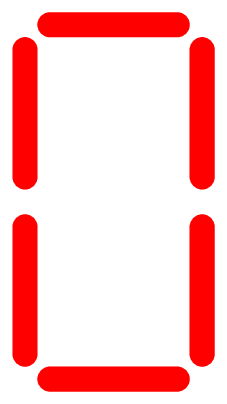Seven segment display with TikZ
A PSTricks solution only for fun purposes. I am really sorry if my algorithm is not so smart, but at least I can save more keystrokes.
Version B
\documentclass[pstricks,border=12pt]{standalone}
\usepackage{pst-node}
\newif\ifa\newif\ifb\newif\ifc\newif\ifd\newif\ife\newif\iff\newif\ifg
\def\seg#1{%
\atrue\btrue\ctrue\dtrue\etrue\ftrue\gtrue
\ifcase#1
\gfalse%0
\or
\afalse\bfalse\cfalse\dfalse\gfalse%1
\or
\bfalse\efalse%2
\or
\bfalse\cfalse%3
\or
\afalse\cfalse\dfalse%4
\or
\cfalse\ffalse%5
\or
\ffalse%6
\or
\bfalse\cfalse\dfalse\gfalse%7
\or
%8
\or
\cfalse%9
\fi
\begin{pspicture}[nodesep=12pt,linewidth=12pt,linecap=1,linecolor=red](3,6)
\pnodes{s}(0,0)(3,0)(3,3)(3,6)(0,6)(0,3)
\ifa\pcline(s3)(s4)\fi
\ifb\pcline(s4)(s5)\fi
\ifc\pcline(s5)(s0)\fi
\ifd\pcline(s0)(s1)\fi
\ife\pcline(s1)(s2)\fi
\iff\pcline(s2)(s3)\fi
\ifg\pcline(s2)(s5)\fi
\end{pspicture}}
\begin{document}
\foreach\i in {0,1,...,9}{\seg{\i}}
\end{document}

Version A
A more compact solution.
\documentclass[pstricks,border=12pt]{standalone}
\usepackage{pst-node}
\def\o#1#2#3{\expandafter\unless\csname if#1\endcsname\pcline(s#2)(s#3)\fi}
\newif\ifa\newif\ifb\newif\ifc\newif\ifd\newif\ife\newif\iff\newif\ifg
\def\p#1{%
\ifcase#1
\gtrue%0
\or
\atrue\btrue\ctrue\dtrue\gtrue%1
\or
\btrue\etrue%2
\or
\btrue\ctrue%3
\or
\atrue\ctrue\dtrue%4
\or
\ctrue\ftrue%5
\or
\ftrue%6
\or
\btrue\ctrue\dtrue\gtrue%7
\or
%8
\or
\ctrue%9
\fi
\begin{pspicture}[nodesep=12pt,linewidth=12pt,linecap=1,linecolor=red](3,6)
\pnodes{s}(0,0)(3,0)(3,3)(3,6)(0,6)(0,3)
\o{a}{3}{4}
\o{b}{4}{5}
\o{c}{5}{0}
\o{d}{0}{1}
\o{e}{1}{2}
\o{f}{2}{3}
\o{g}{2}{5}
\end{pspicture}}
\begin{document}
\foreach\i in {0,1,...,9}{\p\i}
\end{document}
Most likely I do not understand your question. But I'd like to argue that one should first check if the argument is a number (I only check if it is an a but this could be extended) and then use \ifcase for the integer cases.
\documentclass[border=5pt,tikz]{standalone}
\usepackage{ifthen}
\newcommand{\binary}[3]{
\pgfmathtruncatemacro\number{int(#1*2^0+#2*2^1+#3*2^2)}
}
\newcommand{\sieben}[1]{
\draw[gray,opacity=.3,line width=3pt] (0,0) --+ (0,.5);
\draw[gray,opacity=.3,line width=3pt] (0,.6) --+ (0,.5);
\draw[xshift=.7cm,gray,opacity=.3,line width=3pt] (0,0) --+ (0,.5);
\draw[xshift=.7cm,gray,opacity=.3,line width=3pt] (0,.6) --+ (0,.5);
\draw[gray,opacity=.3,line width=3pt] (.1,1.18) --+ (.5,0);
\draw[gray,opacity=.3,line width=3pt] (.1,-.05) --+ (.5,0);
\draw[gray,opacity=.3,line width=3pt] (.1,.55) --+ (.5,0);
\ifthenelse{\equal{#1}{a}}{%\typeout{a}
\draw[red,line width=3pt] (0,0) --+ (0,.5);
\draw[red,line width=3pt] (0,.6) --+ (0,.5);
\draw[red,line width=3pt] (.1,1.18) --+ (.5,0);
\draw[red,line width=3pt] (.1,-.05) --+ (.5,0);
\draw[red,line width=3pt] (.1,.55) --+ (.5,0);
}{%
\ifcase#1
\draw[red,line width=3pt] (0,0) --+ (0,.5);
\draw[red,line width=3pt] (0,.6) --+ (0,.5);
\draw[xshift=.7cm,red,line width=3pt] (0,0) --+ (0,.5);
\draw[xshift=.7cm,red,line width=3pt] (0,.6) --+ (0,.5);
\draw[red,line width=3pt] (.1,1.18) --+ (.5,0);
\draw[red,line width=3pt] (.1,-.05) --+ (.5,0);
\or
\draw[xshift=.7cm,red,line width=3pt] (0,0) --+ (0,.5);
\draw[xshift=.7cm,red,line width=3pt] (0,.6) --+ (0,.5);
\or
\draw[red,line width=3pt] (.1,1.18) --+ (.5,0);;
\draw[xshift=.7cm,red,line width=3pt] (0,.6) --+ (0,.5);
\draw[red,line width=3pt] (.1,.55) --+ (.5,0);
\draw[red,line width=3pt] (0,0) --+ (0,.5);
\draw[red,line width=3pt] (.1,-.05) --+ (.5,0);
\or
\draw[xshift=.7cm,red,line width=3pt] (0,0) --+ (0,.5);
\draw[xshift=.7cm,red,line width=3pt] (0,.6) --+ (0,.5);
\draw[red,line width=3pt] (.1,1.18) --+ (.5,0);
\draw[red,line width=3pt] (.1,-.05) --+ (.5,0);
\draw[red,line width=3pt] (.1,.55) --+ (.5,0);
\or
\draw[red,line width=3pt] (0,.6) --+ (0,.5);
\draw[xshift=.7cm,red,line width=3pt] (0,0) --+ (0,.5);
\draw[xshift=.7cm,red,line width=3pt] (0,.6) --+ (0,.5);
\draw[red,line width=3pt] (.1,.55) --+ (.5,0);
\or
\draw[red,line width=3pt] (0,.6) --+ (0,.5);
\draw[xshift=.7cm,red,line width=3pt] (0,0) --+ (0,.5);
\draw[red,line width=3pt] (.1,1.18) --+ (.5,0);
\draw[red,line width=3pt] (.1,.55) --+ (.5,0);
\draw[red,line width=3pt] (.1,-.05) --+ (.5,0);
\or
\draw[red,line width=3pt] (0,0) --+ (0,.5);
\draw[red,line width=3pt] (0,.6) --+ (0,.5);
\draw[xshift=.7cm,red,line width=3pt] (0,0) --+ (0,.5);
\draw[red,line width=3pt] (.1,1.18) --+ (.5,0);
\draw[red,line width=3pt] (.1,-.05) --+ (.5,0);
\draw[red,line width=3pt] (.1,.55) --+ (.5,0);
\or
\draw[xshift=.7cm,red,line width=3pt] (0,0) --+ (0,.5);
\draw[xshift=.7cm,red,line width=3pt] (0,.6) --+ (0,.5);
\draw[red,line width=3pt] (.1,1.18) --+ (.5,0);
\or
\draw[red,line width=3pt] (0,0) --+ (0,.5);
\draw[red,line width=3pt] (0,.6) --+ (0,.5);
\draw[xshift=.7cm,red,line width=3pt] (0,0) --+ (0,.5);
\draw[xshift=.7cm,red,line width=3pt] (0,.6) --+ (0,.5);
\draw[red,line width=3pt] (.1,1.18) --+ (.5,0);
\draw[red,line width=3pt] (.1,-.05) --+ (.5,0);
\draw[red,line width=3pt] (.1,.55) --+ (.5,0);
\or
\draw[red,line width=3pt] (0,.6) --+ (0,.5);
\draw[xshift=.7cm,red,line width=3pt] (0,0) --+ (0,.5);
\draw[xshift=.7cm,red,line width=3pt] (0,.6) --+ (0,.5);
\draw[red,line width=3pt] (.1,1.18) --+ (.5,0);
\draw[red,line width=3pt] (.1,-.05) --+ (.5,0);
\draw[red,line width=3pt] (.1,.55) --+ (.5,0);
\or
\draw[red,line width=3pt] (0,0) --+ (0,.5);
\draw[red,line width=3pt] (0,.6) --+ (0,.5);
\draw[xshift=.7cm,red,line width=3pt] (0,0) --+ (0,.5);
\draw[xshift=.7cm,red,line width=3pt] (0,.6) --+ (0,.5);
\draw[red,line width=3pt] (.1,1.18) --+ (.5,0);
\draw[red,line width=3pt] (.1,.55) --+ (.5,0);
\or
\fi}}
\begin{document}
\begin{tikzpicture}[xslant=0]
\sieben{a}
\begin{scope}[xshift=1.5cm]
\binary{1}{1}{1} % seven in dual system
\sieben{\number}
\end{scope}
\end{tikzpicture}
\end{document}
